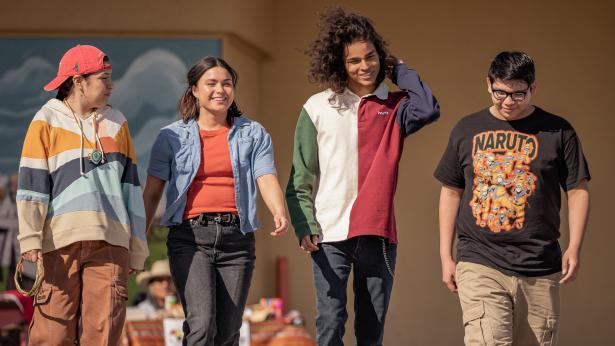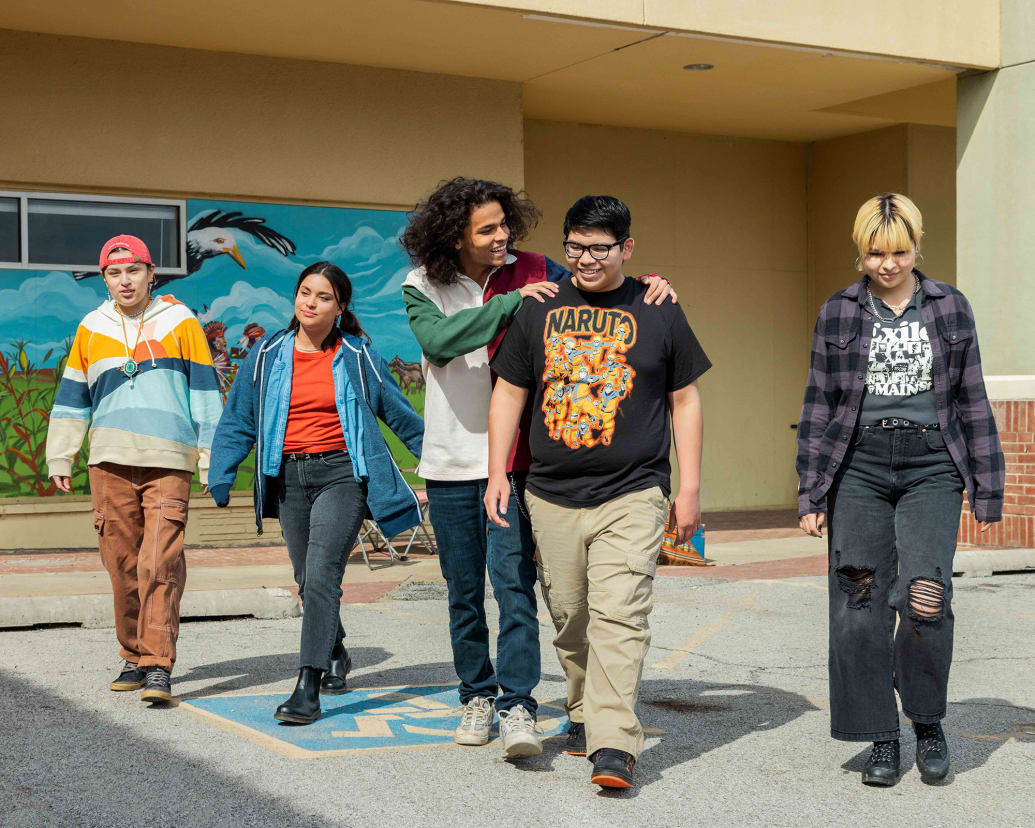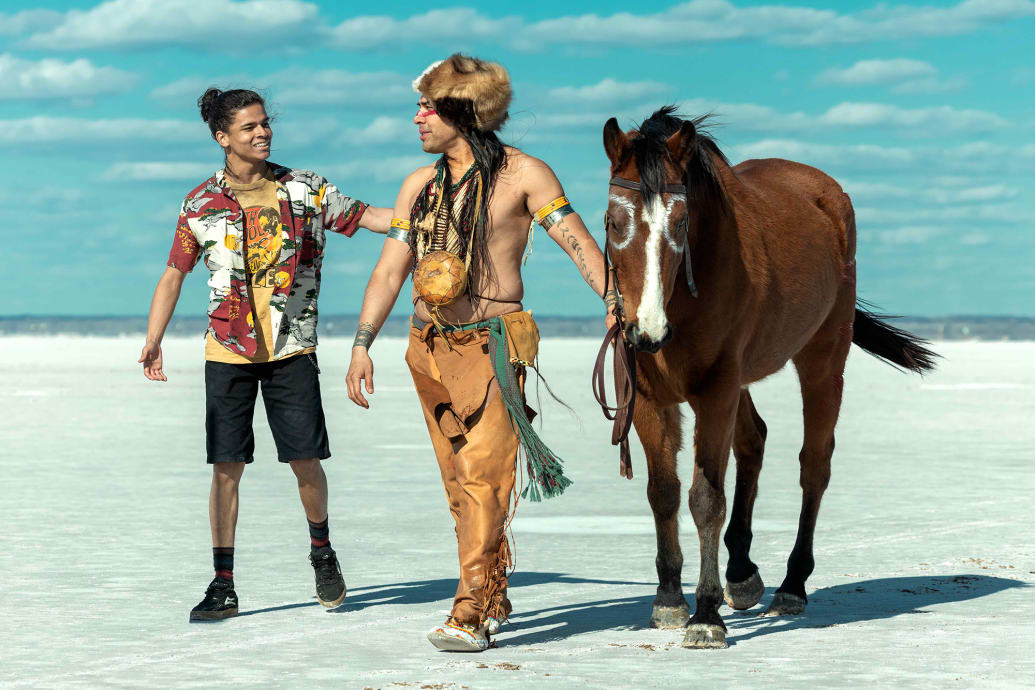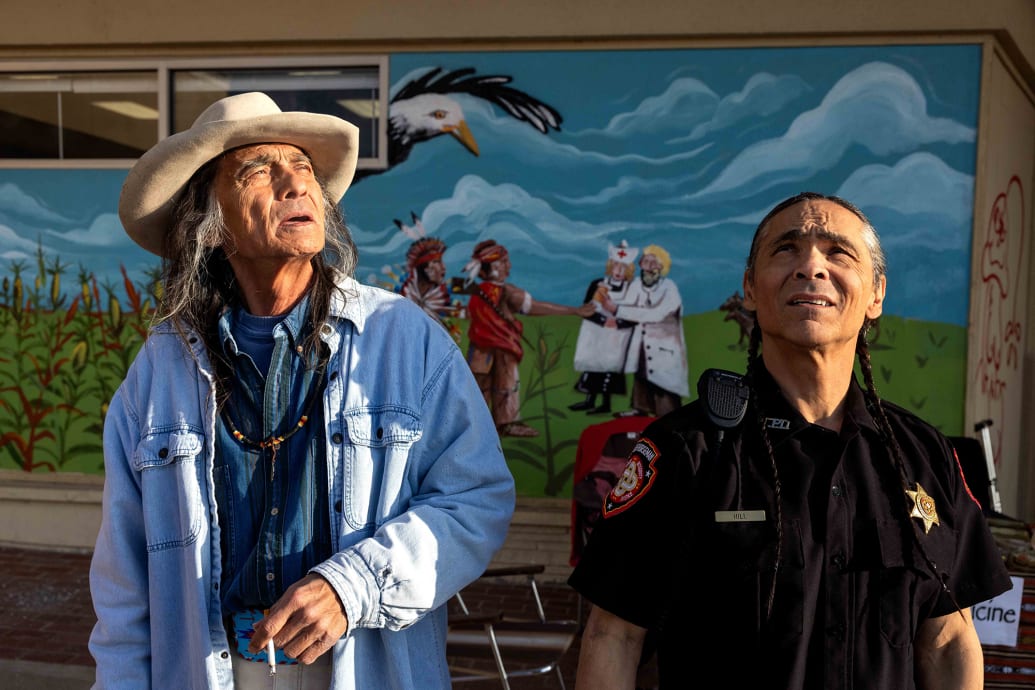For three beautifully honest seasons, we’ve watched Reservation Dogs deftly depict modern Native American life in a way never before seen in TV or film. The nuanced storytelling—courtesy of an all-Indigenous team of writers, directors, and regular actors—captivated audiences from the time it premiered in 2021 and earned creators Sterlin Harjo and Taika Waititi many accolades, including a Peabody Award and a Golden Globe nod. But for Native Americans like me, the real triumph is far greater: The show ushered in a welcome era of authentic Indigenous representation in media.
As an Alaska Native (Tlingit) growing up in northern Minnesota in the ’90s, I rarely saw anyone who looked like me. So I turned to pop culture—think VHS tapes, satellite TV, and nascent dial-up internet—to connect with the rest of the world. The only problem? Native portrayals in entertainment were virtually nonexistent, and the few that did pop up fed into tired tropes. Case in point: There was Disney’s Pocahontas, The Indian in the Cupboard (the VHS tape, no joke, came with an Indian figurine), and a problematic scene in Maverick where Mel Gibson dresses in red face and is hunted by a Russian archduke eager to kill an Indian.
Instead, I settled for a steady diet of TGIF sitcoms that featured mainly white and occasionally Black experiences. The only so-called diversity was situational and slightly outrageous, like a widowed Danny Tanner on Full House, separated-at-birth twins on Sister, Sister, and Perfect Strangers’ Balki Bartokomous from the mythical Mediterranean island of Mypos. Even as my TV tastes matured in adulthood, I still didn’t see myself reflected back onscreen. The underlying message was this: Your people don’t matter enough to be shown.
The effects of this utter lack of representation can’t be overstated. Even today, during an undeniable Native renaissance across spheres from politics (see the historic appointment of Interior Secretary Deb Haaland) to pop culture (see Rez Dogs, Killers of the Flower Moon), genuine portrayals remain woefully low. Recent research from IllumiNative, a social-justice organization combatting Indigenous erasure, found that inclusion of Native characters in primetime TV shows and popular films hovers around 1 percent. Stereotypical depictions and relative invisibility in turn are shown to have marked impacts on Native individuals—particularly youth—negatively affecting our self-understanding, self-esteem, and mental health.
Paulina Alexis, Devery Jacobs, D’Pharaoh Woon-A-Tai, Lane Factor, and Elva Guerra.
Shane Brown/FX
It wasn’t until my mid-thirties that I finally witnessed some real representation, with the debut of Rez Dogs. Honestly, at first I didn’t know what to expect. I was cautiously optimistic that, in the hands of two capable Indigenous creatives, the series would showcase Natives as fully formed human beings living in a modern world. But I never could have imagined it would woo mainstream audiences with its harmonious blend of humor and heartbreak. This accomplishment is especially impressive since the show doesn’t shy away from hard-hitting topics affecting tribal communities as a result of colonialism, including marked inequities, complicated family dynamics, and intergenerational traumas like Indian boarding school experiences.
The storyline centers around four teens coming of age on a fictional Indian reservation and grieving the loss of a friend to suicide. As they try to find their place in the world and consider leaving home, they seek wisdom from elders to better connect to their ancestry. Although technically a scripted series, the dark comedy is as real as it gets; it was filmed on Oklahoma’s Muscogee Nation in tribal members’ homes with nuanced details layered into the set to capture the intricacies of Native life. In short, it offers a rare intimate look into the complex nature of Indigeneity.
D’Pharaoh Woon-A-Tai and Dallas Goldtooth.
Shane Brown/FX
Native peoples have been storytellers for millennia, and yet, Rez Dogs is the first example of Native storytelling by Natives in pop culture—which is why superfans like me were devastated to learn that the third season would be the series’ last. But there’s so much to be grateful for, including standout performances by young Indigenous talent as well as a who’s who roster of notable Native actors making regular appearances. That greats like Graham Greene, Zahn McClarnon, Wes Studi, Amber Midthunder, Gary Farmer, Lily Gladstone, Jana Schmieding, and Michael Spears signed on to the show underscores its significance.
The responsibility to improve Native representation in media isn’t one to be taken lightly. In my recent conversations with actors like Paulina Alexis, who plays Willie Jack on Rez Dogs, and Mo Brings Plenty of Yellowstone, they expressed a deep understanding of the weight on their shoulders as part of the Indigenous reckoning afoot. Although they came of age in different eras, both experienced the effects of Native invisibility, much like me. Now, they’re answering the call to do right for past, present, and future generations.
“If I fail at my job, then I’ve failed our people and our ancestors,” Brings Plenty told me of his role as American Indian affairs coordinator for the Yellowstone universe. He was so affected by the endless messaging that his kind was unwanted during his upbringing across South Dakota’s Lakota Nation that he tried to take his own life as a teenager. After an unsuccessful suicide attempt due to a faulty gun firing pin, his elders convinced him he had a larger purpose in life.
“The kids are really looking up to us right now,” Alexis told me. “One of my biggest responsibilities is just to be a good role model. I want to help kids believe in themselves and feel like they matter.” Growing up on Canada’s Alexis Nakota Sioux reserve with big dreams, she often wondered if she wasn’t booking acting gigs because she was Native. Even at 23, she realizes the impact seeing Indigenous actors like herself, Devery Jacobs, D’Pharaoh Woon-A-Tai, and Lane Factor has on the next generation.
Georgeanne Growingthunder
Shane Brown/FX
As part of today’s Native renaissance, we’re seeing a more open dialogue about Indigenous issues as well as collaborative efforts between Hollywood showrunners and Native communities. Take, for example, Martin Scorsese’s Killers of the Flower Moon, which hits theaters this fall. The famed filmmaker consulted with tribal leaders to accurately tell the story of the 1920s murders of the Osage people over their oil-rich Oklahoma land. Of the partnership, Blackfeet/Nimíipuu star Lily Gladstone said, “There’s that double-edged sword. You want to have more Natives writing Native stories; you also want the masters to pay attention to what’s going on.”
It’s a skillful way of saying that the process of increasing genuine Native representation isn’t going to be perfect. Quite the opposite—it will likely be complicated and challenging. But it’s still an incredibly worthwhile endeavor, because there are so many more stories to tell and myths to dispel. One major hurdle to be overcome? The misconception that Native cultures are a monolith, where in reality there are more than 570 federally recognized tribes in the United States alone, all with their own uniquely beautiful lifeways. Thankfully, countless Indigenous creatives across Turtle Island are already sharing their stories.
And while there’s plenty of work yet to be done, the fact that a TV series like Rez Dogs exists is cause for celebration. It has flipped the script on Indigenous entertainment, making this abundantly clear: No longer will stories be told about Natives without Natives.
Richard Ray Whitman and Zahn McClarnon.
Shane Brown/FX
To the show’s creators, writers, actors, and entire crew, I say thank you. You have helped me embrace my own Alaska Native identity on my journey of healing—something you’ve done for countless Native Americans who have spent years questioning their worth in a world that told us we didn’t belong. Although I didn’t grow up seeing my own culture properly depicted in media, I’m confident we’ve reached a critical moment and can’t return to a time of ignorance about the atrocities Indigenous communities have endured. Reservation Dogs is a salient reminder that we are still here.
Keep obsessing! Sign up for the Daily Beast’s Obsessed newsletter and follow us on Facebook, Twitter, Instagram and TikTok.






Spread the word